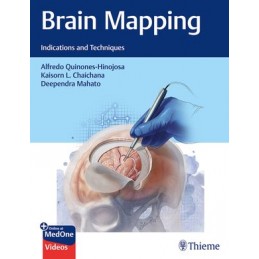- Reduced price

Order to parcel locker

easy pay


 Delivery policy
Delivery policy
Choose Paczkomat Inpost, Orlen Paczka, DHL, DPD or Poczta Polska. Click for more details
 Security policy
Security policy
Pay with a quick bank transfer, payment card or cash on delivery. Click for more details
 Return policy
Return policy
If you are a consumer, you can return the goods within 14 days. Click for more details
Comprehensive resource features state-of-the-art brain mapping techniques and pearls from international recognized neurosurgeons Alfredo Quinones-Hinojosa and Kaisorn Chaichana and coeditor Deependra Mahato
Despite advances in imaging techniques to identify eloquent cortical brain regions and subcortical white matter, brain mapping is the only method for obtaining real-time information with high sensitivity and specificity. This groundbreaking technology greatly enhances the neurosurgeons ability to safely resect challenging lesions located in eloquent areas of the brain. Brain Mapping:: Indications and Techniques by esteemed neurosurgeons Alfredo Quinones-Hinojosa, Kaisorn Chaichana, and Deependra Mahato, is a comprehensive overview of the most critical aspects of brain mapping from leaders in the field.
The book starts with discussion of preoperative aspects, including the history of brain mapping and anatomy of eloquent cortical and eloquent white matter tracts. Subsequent chapters cover perioperative aspects of brain mapping including indirect and direct functional mapping, the role of neurophysiology, awake craniotomy operating room set-up and surgical instruments, and anesthetic considerations. Diverse awake and asleep brain mapping techniques are described for various intracranial pathologies, as well as advances in postoperative recovery of neurological function including physical and speech therapy.
Key Features
This is the most comprehensive resource available to date on brain mapping and surgery in eloquent regions. As such, it is a must-have for neurosurgical residents, fellows, practicing neurosurgeons, and allied healthcare practitioners who treat patients with brain conditions.
This book includes complimentary access to a digital copy on https://medone.thieme.com.
Data sheet
Section I: Preoperative Brain Mapping Features
Part 1: Brain Anatomy and Pathology
1 The Early History of Intraoperative Brain Mapping
2 Anatomy of Eloquent Cortical Brain Regions
3 Anatomy of Eloquent White Matter Tracts
Part 2: Preoperative Mapping Adjuncts
4 Direct Functional Mapping Using Radiographic Methods (fMRI and DTI)
5 Indirect Functional Mapping Using Radiographic Methods
6 Neurophysiology of Identifying Eloquent Regions
7 Extraoperative Mapping for Epilepsy Surgery: Epilepsy Monitoring, Wada, and Electrocorticography
8 Neuropsychologists Role in the Management of Brain Tumor Patients
Section II: Intraoperative Brain Mapping
Part 1: Awake
9 Awake Craniotomy Operating Room Setup and Surgical Instruments
10 Anesthetic Considerations for Intraoperative Cerebral Brain Mapping
11 Speech Mapping
12 Motor Mapping (Rolandic, Pre-Rolandic, and Insular Cortex)
13 Awake Subcortical Mapping of the Ventral and Dorsal Streams for Language
14 Surgery Around the Command and Control Axis: The Default Mode, Control, and Frontal Aslant Systems
15 Mapping and Surgery of Insular Tumors
16 Mapping of the Visual Pathway
17 Seizure Mapping Surgery
Part 2: Asleep
18 Asleep Motor Mapping
19 Brainstem and Spinal Cord Mapping
Section III: Postoperative Brain Mapping for Recovery of Function
20 Importance of Rehabilitation after Eloquent Brain Surgery
21 Emergence of Deep Learning Methods for Deep Brain Stimulation-Evoked Functional Connectomics
22 Neuroplasticity and Rewiring of the Brain
23 Radiating in Eloquent Regions
Reference: 80455
Author: Pierre Roussouly
Reference: 92815
Author: Randal R. Betz
Reference: 92895
Author: Michael Sabel
Reference: 94309
Author: Manas Panigrahi
